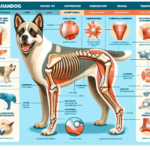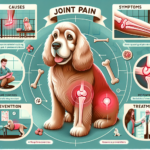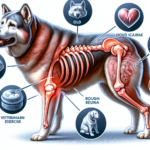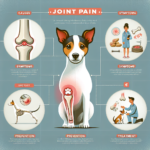Chinook Joint Pain: Causes, Symptoms, Prevention, and Treatment

Introduction
The Chinook is a rare and versatile breed known for its strength, endurance, and friendly disposition. Originating in the United States, the breed was developed in the early 20th century by Arthur Treadwell Walden, who aimed to create a superior sled dog. Chinooks are medium to large-sized dogs with a muscular build, a dense double coat, and a distinctive tawny color. They are known for their intelligence, loyalty, and gentle nature, making them excellent family pets and working dogs.
Like many breeds, Chinooks are prone to certain health issues, with joint pain being a significant concern. Joint health is crucial for maintaining the breed’s active lifestyle and overall well-being. Understanding the causes, symptoms, prevention, and treatment of joint pain in Chinooks can help owners ensure their dogs lead healthy, pain-free lives.
Breed-Specific Joint Pain Risks
Genetic Predisposition
Chinooks have a genetic predisposition to several joint-related issues, including hip dysplasia, elbow dysplasia, and arthritis. Hip dysplasia is a common condition where the hip joint does not fit properly into the hip socket, leading to pain and mobility issues. Elbow dysplasia involves abnormal development of the elbow joint, causing lameness and discomfort. Arthritis, a degenerative joint disease, can also affect Chinooks, leading to chronic pain and stiffness.
Age-Related Risks
As Chinooks age, the risk of developing joint pain increases. Senior Chinooks, typically those over seven years old, are more susceptible to arthritis and other degenerative joint conditions. It’s essential for owners to monitor their dogs for signs of joint pain as they age and to provide appropriate care to manage any issues that arise.
Activity Level and Joint Stress
Chinooks are known for their high energy levels and love for physical activities such as running, hiking, and pulling sleds. While regular exercise is vital for their overall health, excessive or high-impact activities can put stress on their joints, potentially leading to injuries and chronic pain. It’s crucial to balance their activity levels to prevent joint stress while keeping them fit and healthy.
Common Symptoms of Joint Pain in Chinooks
General Symptoms
- Limping or favoring one leg
- Stiffness, especially after rest or exercise
- Reluctance to move, jump, or climb stairs
- Decreased activity or interest in play
- Swelling or heat around the joints
- Whining or showing signs of discomfort when touched
Breed-Specific Symptoms
In Chinooks, joint pain may manifest as a reluctance to participate in activities they once enjoyed, such as pulling sleds or running. They may also show a noticeable decrease in endurance and stamina during physical activities. Owners should be vigilant for these breed-specific signs and take action if they notice any changes in their dog’s behavior or activity levels.
When to Consult a Vet
If a Chinook exhibits any signs of joint pain, it’s essential to consult a veterinarian promptly. Early diagnosis and intervention can help manage the condition and prevent further deterioration. Owners should seek veterinary advice if their dog shows persistent limping, stiffness, or reluctance to move, as these symptoms may indicate a more serious underlying issue.
Preventive Measures for Joint Health
Exercise Recommendations
Regular, low-impact exercise is crucial for maintaining joint health in Chinooks. Activities such as swimming, walking, and controlled play can help keep their joints flexible and muscles strong without causing excessive stress. It’s important to avoid high-impact activities like jumping or running on hard surfaces, which can exacerbate joint issues.
Dietary Suggestions
A balanced diet rich in essential nutrients can support joint health in Chinooks. Foods containing glucosamine, chondroitin, and omega-3 fatty acids are particularly beneficial for joint maintenance. Owners may also consider supplements specifically designed to promote joint health, but it’s essential to consult a veterinarian before adding any new supplements to their dog’s diet.
Weight Management
Maintaining a healthy weight is crucial for reducing joint stress in Chinooks. Excess weight can put additional pressure on the joints, leading to pain and mobility issues. Owners should monitor their dog’s weight and adjust their diet and exercise routine as needed to ensure they stay within a healthy weight range.
Early Screening and Monitoring
Regular veterinary check-ups and early screening for joint issues can help catch problems before they become severe. For Chinooks, screening tests such as hip and elbow evaluations can identify potential issues early on, allowing for timely intervention and management. Owners should work closely with their veterinarian to develop a monitoring plan tailored to their dog’s needs.
Treatment Options for Joint Pain
Non-Surgical Treatments
Non-surgical treatments for joint pain in Chinooks include medications, physical therapy, and lifestyle adjustments. Anti-inflammatory medications and pain relievers can help manage pain and reduce inflammation. Physical therapy, including exercises and massage, can improve joint mobility and strength. Lifestyle adjustments, such as providing a comfortable bed and avoiding high-impact activities, can also alleviate joint pain.
Surgical Options
In severe cases of joint pain, surgical intervention may be necessary. Common surgical options for Chinooks include hip replacement, arthroscopy, and joint fusion. These procedures can help alleviate pain and improve mobility, but they come with risks and require a significant recovery period. Owners should discuss the potential benefits and risks of surgery with their veterinarian to determine the best course of action for their dog.
Alternative Therapies
Alternative therapies such as acupuncture, hydrotherapy, and massage can provide additional relief for Chinooks with joint pain. Acupuncture involves inserting thin needles into specific points on the body to relieve pain and promote healing. Hydrotherapy, or water therapy, allows dogs to exercise in a low-impact environment, reducing joint stress. Massage can help improve circulation and reduce muscle tension, providing relief from joint pain.
Lifestyle and Management Tips
Daily Care Routine
A consistent daily care routine can help manage and alleviate joint pain in Chinooks. This routine may include gentle exercise, a balanced diet, and regular veterinary check-ups. Owners should also provide a comfortable sleeping area with orthopedic bedding to support their dog’s joints.
Modifying the Home Environment
Making the home environment more comfortable for a dog with joint pain can significantly improve their quality of life. Owners can install ramps to help their dog navigate stairs or get onto furniture without jumping. Providing non-slip flooring and keeping the living area free of obstacles can also prevent falls and reduce joint stress.
Long-Term Management
Long-term management of joint pain in Chinooks involves a combination of regular veterinary care, appropriate exercise, a balanced diet, and weight management. Owners should remain vigilant for any changes in their dog’s condition and adjust their care routine as needed to ensure their dog remains active and happy despite joint pain.
FAQs About Chinooks and Joint Pain
What are the early signs of joint pain in Chinooks?
Early signs of joint pain in Chinooks include limping, stiffness, reluctance to move, and decreased activity levels. Owners should monitor their dogs for these symptoms and consult a veterinarian if they notice any changes in their dog’s behavior or mobility.
Can joint pain in Chinooks be prevented?
While it’s not always possible to prevent joint pain entirely, owners can take steps to reduce the risk. Regular, low-impact exercise, a balanced diet, weight management, and early screening for joint issues can all help maintain joint health and prevent pain.
Are there specific supplements that can help with joint health in Chinooks?
Yes, supplements containing glucosamine, chondroitin, and omega-3 fatty acids can support joint health in Chinooks. However, it’s essential to consult a veterinarian before adding any new supplements to their diet.
When should I consider surgery for my Chinook’s joint pain?
Surgery should be considered when non-surgical treatments are no longer effective, and the dog’s quality of life is significantly impacted by joint pain. Owners should discuss the potential benefits and risks of surgery with their veterinarian to determine the best course of action.
What types of exercises are best for Chinooks with joint pain?
Low-impact exercises such as swimming, walking, and controlled play are best for Chinooks with joint pain. These activities help maintain joint flexibility and muscle strength without causing excessive stress on the joints.
Conclusion
Joint pain is a significant concern for Chinooks, but with proper care and management, owners can help their dogs lead healthy, active lives. By understanding the causes, symptoms, prevention, and treatment options for joint pain, owners can take proactive steps to support their dog’s joint health. Regular veterinary check-ups, a balanced diet, appropriate exercise, and weight management are all crucial components of maintaining joint health in Chinooks. By staying vigilant and taking preventive measures, owners can ensure their beloved pets remain happy and pain-free.




